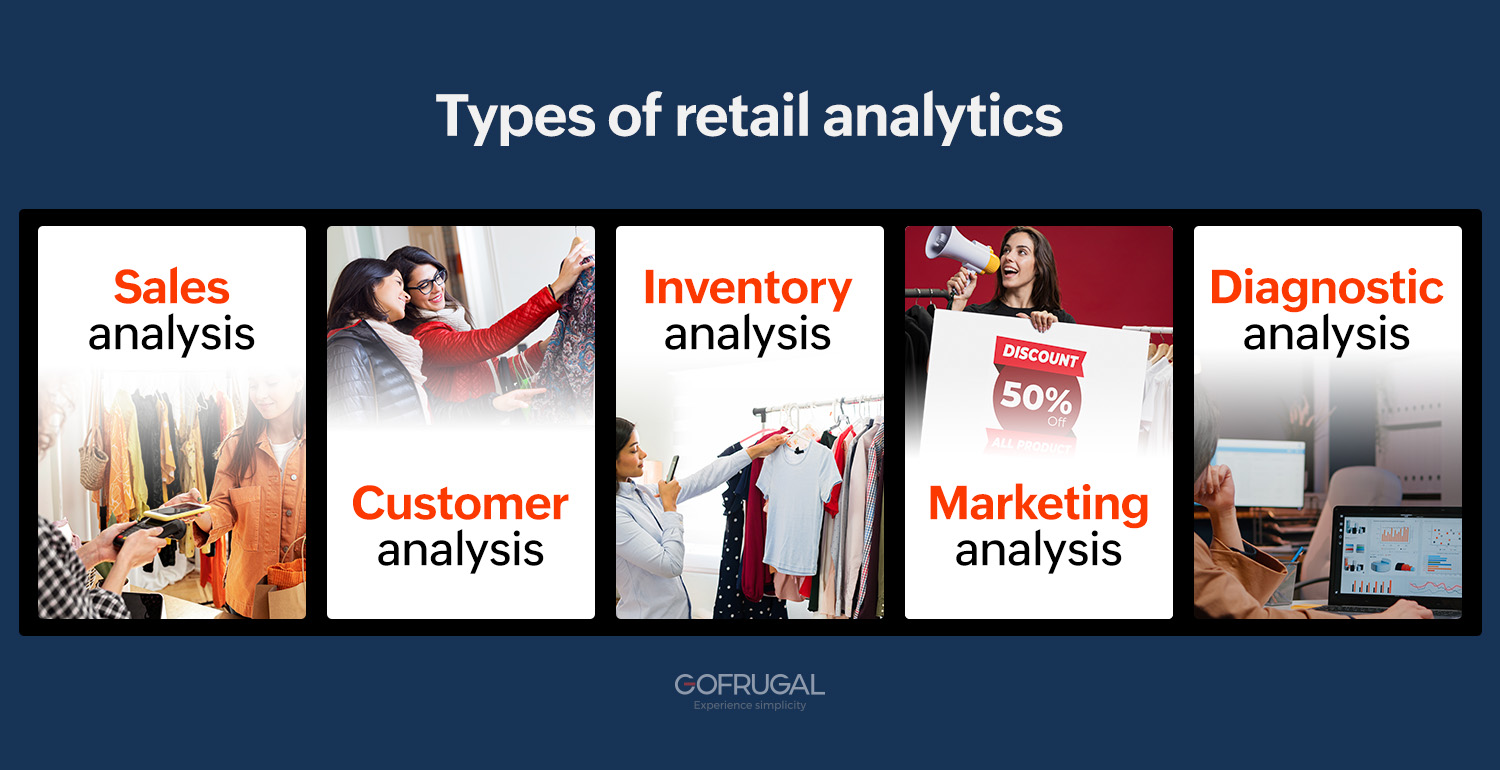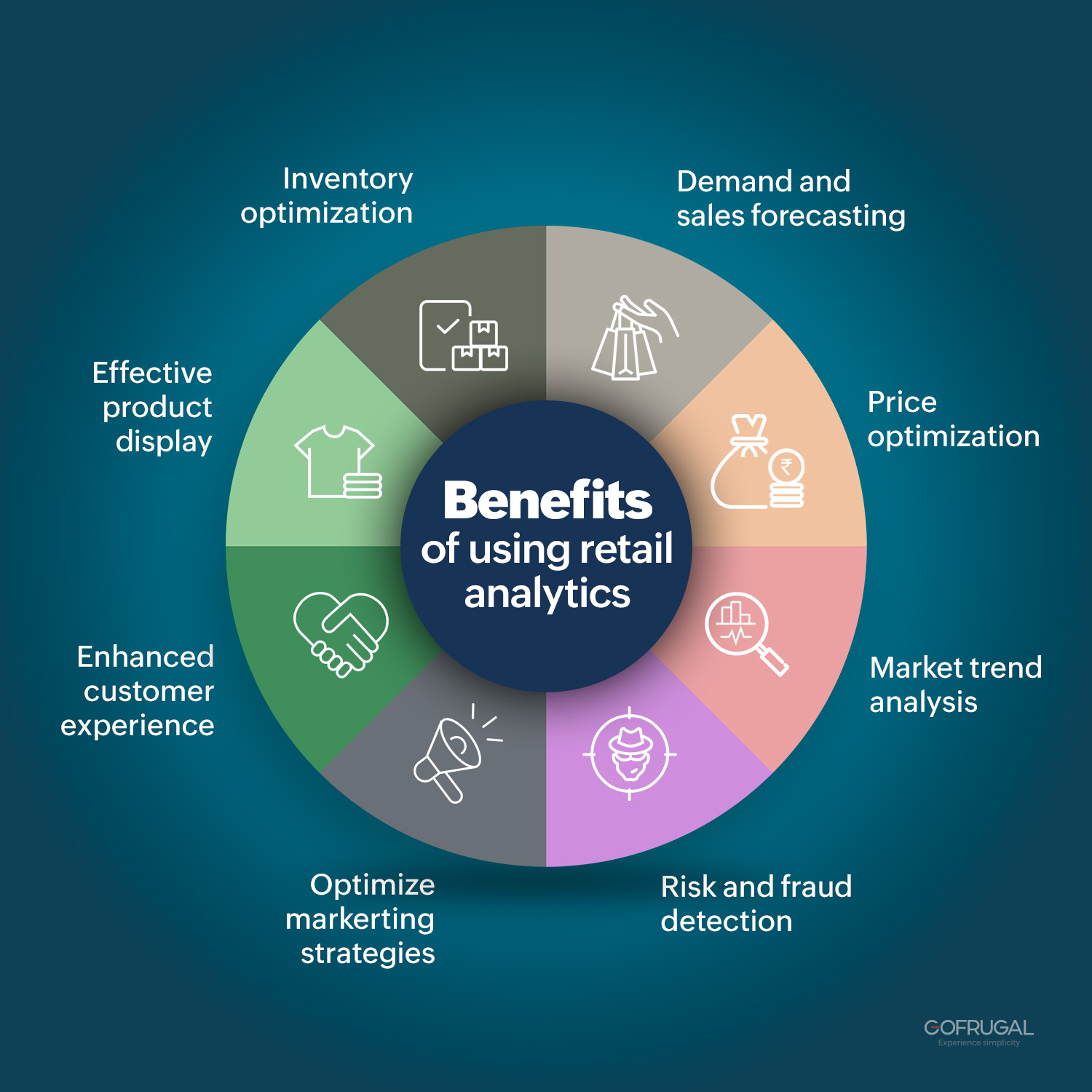Step into the shoes of a retail store owner, where every decision shapes the destiny of your business. Behind the scenes, retail analytics serves as your silent partner, guiding each move from inventory shelves to marketing campaigns. Recent studies show that businesses utilizing retail analytics experience significant boosts in sales and profitability. With the power of data-driven insights, retailers can unlock hidden patterns, foresee customer trends, and fuel their business expansion. Get ready to explore how retail analytics is revolutionizing the retail industry and discover practical insights that you can apply to your own business journey.
Contents
- What is retail analytics?
- Types of retail analytics
- Benefits of using retail analytics
- How retailers can use analytics
- Best practices of retail analytics
- How Gofrugal empowers retailers with its analytical tools
- Customer case study
What is retail analytics?
Retail analytics, is the process of gathering, analyzing, and interpreting data to better understand customer preferences, sales trends, and store performance. It helps retailers make smarter decisions to improve efficiency, enhance customer experiences, and increase sales. Key elements include forecasting sales trends, integrating data from online and offline channels, providing real-time insights, personalizing marketing efforts, and comparing performance with competitors.
Why is data analytics important in the retail industry?
Data analytics plays a crucial role in the retail industry by offering insights that drive better decisions and business growth. Retail analytics helps businesses understand what customers want, spot sales trends, and streamline store operations. Using retail analytics software, stores can monitor product performance, manage inventory effectively to prevent stock issues, and personalize customer experiences for stronger loyalty.
Retail business analytics takes data from every part of the store—sales, inventory, and customer interactions—and turns it into actionable insights. This means retailers can adjust quickly to market changes, fine-tune marketing strategies, and gain an edge over competitors, staying relevant in a fast-moving industry.
Types of retail analytics
Retail analytics, also known as retail data analytics, involves gathering and analyzing data to optimize various aspects of retail operations, from sales to inventory and customer engagement. Below are key types of retail store analytics, each offering unique benefits:
1. Sales analysis: Sales analysis is a key component of retail store analytics, helping track and understand sales performance across products, categories, and periods. By analyzing sales data, retailers can identify trends and opportunities, refine marketing strategies, adjust pricing, and improve product assortment. This type of analytics for retail also aids in forecasting future sales, setting targets, and measuring campaign success.
2. Customer analysis: Customer analysis focuses on gathering and interpreting data on customer demographics, preferences, and shopping behavior. By leveraging retail store analytics, retailers can segment customers, personalize marketing, and improve customer experience. This analysis is essential for identifying loyal customers, targeting new segments, and increasing retention through tailored promotions and communication.
3. Inventory analysis: Inventory analysis helps optimize stock levels, turnover rates, and supply chain efficiency. Real-time monitoring and demand forecasting through retail analytics software help retailers minimize stockouts and avoid overstocking. This approach identifies slow-moving items, optimizes reorder points, and streamlines procurement, improving cash flow and reducing excess inventory costs.
4. Marketing analysis: Marketing analysis evaluates the impact of promotional efforts, advertising, and customer engagement initiatives. Using retail business analytics, retailers can measure return on investment (ROI), identify the most successful channels, and allocate marketing resources more effectively. This type of retail analytics helps businesses achieve their objectives by focusing on high-performing strategies.
5. Diagnostic analytics: Diagnostic analytics digs deeper into retail data analytics to reveal the reasons behind specific performance trends or anomalies. By identifying root causes, this type of analytics helps retailers address underlying issues and improve processes, resulting in more efficient and effective operations.
Benefits of Retail Analytics
- Improved decision-making: Analytics for retail helps businesses gain valuable insights into customer behaviour, market trends, and operational efficiencies. These insights empower retailers to make informed decisions that drive growth and enhance profitability.
- Enhanced customer experience: Retail business analytics enables businesses to understand customer preferences better and tailor their offerings accordingly. By analyzing data on customer interactions and feedback, retailers can personalize marketing campaigns, optimize pricing strategies, and deliver superior customer experiences.
- Optimized inventory management: With retail data analysis, businesses can predict demand patterns more accurately, leading to optimized inventory levels and reduced instances of stockouts or overstocking. This not only improves operational efficiency but also minimizes excess inventory costs.
- Increased sales and margins: Retail store analytics helps businesses identify sales trends and opportunities for revenue growth. By analyzing customer purchasing behaviour and product performance data, retailers can optimize pricing strategies, identify cross-selling opportunities, and maximize sales and margins.
- Competitive advantage: By staying ahead of emerging trends and consumer preferences through retail analysis, businesses can gain a competitive edge in the market. Retail analytics enables retailers to anticipate market shifts, tailor marketing strategies, and proactively adapt their offerings to outshine competitors.
What is Retail data analytics?
Retail data analytics software helps retailers turn data into useful insights, making it easier to understand customer habits, sales trends, and store performance. With this tool, businesses can make better decisions, manage stock more effectively, improve customer experiences, and boost profits. From tracking what sells best to learning about customer preferences, retail analytics helps stores stay competitive in a fast-changing market.
Retail Analytics Tools
Retail analytics tools help stores understand different areas of their business better. Here are some key tools that drive retail data insights:
- POS Systems (Point of Sale): POS systems track sales at checkout, showing which products sell best, peak shopping times, and customer favourites. This helps stores keep the right items in stock and plan for busy times.
- CRM (Customer Relationship Management): CRM tools store customer details, shopping habits, and feedback. This lets stores personalize offers and improve customer experiences, making shoppers feel valued and increasing loyalty.
- BI (Business Intelligence): Business Intelligence tools collect data from across the store to show overall performance. This helps retailers make smart choices on stock, sales, and staffing, keeping the store running smoothly.
- Inventory Management Software: These tools track stock levels and help plan restocking. They ensure that stores have the right products on hand, reducing both empty shelves and overstock.
- Marketing Analytics Software: These tools review how promotions and ads perform. By understanding customer responses, stores can focus on the best ways to reach their audience and make the most of their marketing budget.
- E-commerce Analytics: These tools track online shopping behavior, such as browsing patterns, cart abandonment rates, and purchase trends. They help retailers understand digital customer journeys and improve online sales strategies, essential in today’s omnichannel environment.
Each tool in retail analytics helps stores make better decisions, run efficiently, and provide great customer experiences.
How retailers can use analytics
Retailers can harness the power of analytics to improve various aspects of their operations and drive business growth. Here's how they can utilize analytics effectively.
- By analyzing past data, analytics provides insights into performance, diagnostic issues, suggests improvements, and forecasts demand. These insights empower retailers to optimize sales, profits, and customer satisfaction.
- By analyzing sales data and inventory levels, retailers can identify trends and forecast demand more accurately. For example, if analytics reveals that certain products are selling faster than others, retailers can adjust their inventory levels accordingly to prevent stockouts.
- Pricing analytics can help retailers determine the optimal pricing strategy for their products. By analyzing market trends, competitor pricing, and customer behavior, retailers can set prices that maximize profitability while remaining competitive. For instance, retailers can use dynamic pricing algorithms to adjust prices in real time based on demand and market conditions.
- In-store analytics leverage POS systems and video cameras to analyze customer behavior, optimize product placement, manage inventory levels, and deter theft.
- Customer analytics utilize data from multiple touchpoints to identify popular items, understand return patterns, and optimize marketing strategies.
- Merchandise analytics focuses on effective product display and pricing strategies to drive sales and improve profit margins.
- Web analytics track online consumer behavior to optimize website layout, pricing, and marketing promotions.
- Business intelligence reportsoffer preset KPIs to monitor trends and inform decision-making at all levels of the organization.
- Demand forecasting predicts online item demand based on customer interactions, while sales forecasting uses actual sales data to predict future sales and ensure adequate inventory management across all channels. These analytics tools collectively enable retailers to make data-driven decisions and stay ahead in a competitive market.
Best practices of Retail Analytics
Retail analytics is essential for retailers to make informed decisions and drive business growth. Here are key strategies and approaches to effectively implement and utilize retail analytics.
- Integrated data sources: Integrate various data sources such as sales data, customer data, inventory data, and external market data to gain a comprehensive view of business operations.
- Advanced analytics techniques: Utilize advanced analytics techniques like predictive modelling, machine learning, and AI algorithms to extract valuable insights and forecast future trends.
- Real-time analytics: Implement real-time analytics capabilities to monitor and respond to changing market conditions, customer behaviour, and inventory levels promptly.
- Segmentation and personalization: Segment customers based on demographics, purchase history, and behaviour to tailor marketing efforts and offers, enhancing customer experience and loyalty.
- Data visualization: Use data visualization tools to present insights clearly and intuitively, enabling stakeholders to understand complex data and make informed decisions.
- Continuous improvement: Continuously refine analytics strategies and processes based on feedback, market dynamics, and technological advancements to stay competitive and drive innovation.
- Cross-functional collaboration: Foster collaboration between departments such as sales, marketing, and operations to ensure alignment and maximize the value derived from retail analytics.

How Gofrugal empowers retailers with its analytical tools
Gofrugal's analytics suite stands at the forefront of guiding retailers towards informed decisions and effortless execution.
- POS systems: Gofrugal's advanced POS systems track customer purchases, offering insights into sales patterns and popular items. This data empowers stores to optimize inventory levels and streamline checkout processes, enhancing customer satisfaction.
- CRM software: Gofrugal's CRM software facilitates effective customer interaction management, enabling personalized offers and promotions. You can execute a marketing campaign from Exclusife based on customer buying patterns.
- Business intelligence tools: Gofrugal's BI tools analyze vast data sets to extract actionable insights, aiding in informed decision-making. With intuitive dashboards and customizable reports, retailers identify growth opportunities and drive profitability.
- Inventory management systems:GoSure app provides advanced inventory management capabilities, including real-time stock updates and automated replenishment. It prevents stockouts and minimizes excess inventory costs, ensuring optimal inventory levels.
- Predictive analytics: Gofrugal's predictive analytics, exemplified by The Eye, enables purchase automation by forecasting future demand and optimizing purchasing decisions. With automated reorder suggestions and vendor performance analysis, retailers enhance operational efficiency and maximize profitability.
A multi-outlet retail store optimizes billing and inventory seamlessly with Gofrugal
One of our long-term customers scaled from e-commerce to a thriving multistore chain with Gofrugal! They share how Gofrugal simplified inventory management, sales tracking, and GST compliance for their pooja shopping business.
In conclusion, the transformative impact of retail analytics cannot be overstated. With the right tools and insights, retailers can navigate the complexities of the industry easily, driving success and growth. That's where Gofrugal's suite of analytical tools shines brightest. From advanced POS systems to intuitive CRM software and powerful predictive analytics, Gofrugal seamlessly integrates into every aspect of your retail operation, empowering you to make smarter decisions, streamline processes, and deliver exceptional customer experiences. With Gofrugal by your side, success becomes not just a goal, but a seamless journey towards retail excellence.



